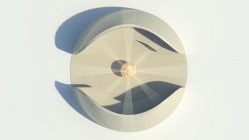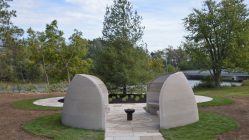Architect Douglas Cardinal says teachings of First Nations needed by troubled world
THOROLD — Douglas Cardinal hopes the stone monument he envisioned will be a symbol, as it has now become a reality in Thorold’s Decew House Heritage Park.
The internationally-renowned architect, whose heritage is Blackfoot, hopes it will be a symbol of how the world can learn — perhaps even survive — if it learns the centuries-old teachings of First Nations peoples.
On Saturday, Oct. 7, at the unveiling of the Indigenous peace monument — mere steps from where First Nations warriors escorted War of 1812 heroine Laura Secord to her fateful meeting with the British garrison stationed there — Cardinal told hundreds of people gathered that for thousands of years, First Nations elders have taught the importance of love, forgiveness and peace.
“We were always taught that the soft power of love is much greater than the hard power of force,” he said. “We were taught … to always forgive, so we could always have our hearts open for loving and caring.”
The monument’s unveiling comes as Canada is finally coming to terms with the historical injustices against Indigenous people, along with the national acknowledgment of the role of First Nations people in Canada’s inception, defence, culture, wealth and national character.
“We, in a sense, have gone through apartheid and genocide; crimes against humanity,” said Cardinal.
But, the First Nations teachings of forgiveness, striving for peace and valuing all of nature are something people of all cultures in this war-torn world battered by pollution and global warming can learn from, he said.
“Those teachings have to be taught to everybody,” said Cardinal. “Unless we teach people to love and care for all life on this planet, we won’t have a future.”
Richard Hill, a historian from Six Nations, said the monument spearheaded by the Friends of Laura Secord group is symbolic of the need to fight injustice at a time when so much of the world is in conflict.
“Peace is like a tree; it will keep growing, but people have to nurture it,” he said. “With what’s going on in the world today, I feel that our tree of peace is in sincere jeopardy.”
Ontario Lt.-Gov. Elizabeth Dowdeswell said the monument urges people to contemplate how we can make Canada a more inclusive place and foster the kind of empathy that encourages healing.
“All too often, Indigenous peoples bear the brunt of history, with their stories continuing to be neglected or ignored — or even outright erased,” she said. “This monument will tell generations of Canadians about that story.
“The act of acknowledging their ancient and enduring presence is a crucial step to realizing a more just and sustainable country. This monument reminds us that we can only build that country together,” said Dowdeswell.
“Long may it serve as a peaceful haven, an educational site, an inspiration for people as we walk the long and difficult path of reconciliation.”
Niagara Centre riding MP Vance Badawey said the monument will help people across the province and country to celebrate the contributions of Indigenous people, while Thorold Mayor Ted Luciani said it’s a big step forward in the reconciliation process.
“(It’s) a stunning piece art,” said Luciani. “We embrace its symbolic significance.”
Friends of Laura Secord president Caroline McCormick said War of 1812 bicentennial work to celebrate Secord’s famous trek from Queenston to bring warning of an impending attack by American soldiers — which led to a key defeat of the invaders by First Nations warriors allied with the British — showed her how little she actually knew of the history of Indigenous peoples over thousands of years.
“I realized how ignorant I was and that these stories needed to be told, and others need to understand this important contribution,” she said.
The monument will serve as a permanent reminder of how early settlers and the resident First Nations people joined together to defend a country still in its infancy,” said McCormick.
“How wonderful that this monument is situated at this sacred site where Canadian history was made,” she said.
Tim Johnson, a Mohawk from Six Nations who is a senior adviser to the Friends group — and who played a central role in getting Cardinal involved in the project — said the monument isn’t just about the role of First Nations in the battle and the war.
“(It’s) intended to help generate a deeper understanding of the rich heritage and ongoing heritage of First Nations, and illuminate their vital contributions to the founding and evolving identity of Canada.”
Source: niagarathisweek.com, Article by Paul Forsyth, Niagara This Week




Add comment